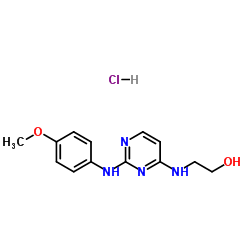671225-39-1
| Name | Cardiogenol C hydrochloride |
|---|---|
| Synonyms |
Ethanol, 2-[[2-[(4-methoxyphenyl)amino]-4-pyrimidinyl]amino]-, hydrochloride (1:1)
2-({2-[(4-Methoxyphenyl)amino]pyrimidin-4-yl}amino)ethanol hydrochloride (1:1) 2-({2-[(4-Methoxyphenyl)amino]-4-pyrimidinyl}amino)ethanol hydrochloride (1:1) |
| Description | Cardiogenol C is a potent cell-permeable pyrimidine inducer which prompts the differentiation of ESCs into cardiomyocytes (EC50=100 nM)[1]. Cardiogenol C also acts cardiomyogenic on already lineage-committed progenitor cell types with a limited degree of plasticity. Cardiogenol C is a useful cardiomyogenic agent and can be used as a tool to improve cardiac repair by cell transplantation therapy in animal models[2]. |
|---|---|
| Related Catalog | |
| Target |
EC50: 100 nM (differentiation of ESCs into cardiomyocytes)[1] |
| In Vitro | Cardiogenol C (1 μM; 7 days) has a cardiomyogenic effect on P19 cells, it significantly increases atrial natriuretic factor (ANF, nppa) in P19 cells when it compares to untreated control cells[1]. Cardiogenol C (0.01-100 μM; 7 days) significantly increases ANF expression. In addition, another frequently used cardiac marker gene (NKX2-5) is also significantly increased by this small molecule in C2C12 cells[2]. Cardiogenol C (0.001-100 μM; 7 days) increases cardiac Nav1.5 sodium channel protein expression as dose-dependent manner in C2C12 cells[2]. Cardiogenol C (0.01-100 μM; 7 days) does not effect cell growth even at 10 μM. In addition, Cardiogenol C either solves in water or DMSO generates a similar effect. The highest concentration, 100 μM has significant cellular toxicity on C2C12 cells[2]. RT-PCR[2] Cell Line: C2C12 cells Concentration: 0.01 μM; 0.1 μM; 1 μM; 3 μM; 10 μM; 30 μM; 100 μM Incubation Time: 7 days Result: Increases ANF and NKX2.5 mRNA level as a dose-dependent manner. Western Blot Analysis[2] Cell Line: C2C12 cells Concentration: 0.001 μM; 0.01 μM; 0.1 μM; 1 μM; 10 μM Incubation Time: 7 days Result: Increased cardiac Nav1.5 sodium channel protein levels. Cell Proliferation Assay[2] Cell Line: C2C12 cells Concentration: 0.01 μM; 0.1 μM; 1 μM Incubation Time: 7 days Result: Did not exert toxic effects on C2C12 cells at 0.01-10 μM treatment. |
| References |
| Density | 1.305g/cm3 |
|---|---|
| Boiling Point | 520.3ºC at 760 mmHg |
| Molecular Formula | C13H16N4O2 |
| Molecular Weight | 296.753 |
| Flash Point | 268.5ºC |
| Exact Mass | 296.104004 |
| PSA | 79.30000 |
| LogP | 2.58100 |
| Index of Refraction | 1.667 |
| Storage condition | -20℃ |
| Symbol |

GHS07 |
|---|---|
| Signal Word | Warning |
| Hazard Statements | H315-H319-H335 |
| Precautionary Statements | P261-P305 + P351 + P338 |
| Personal Protective Equipment | dust mask type N95 (US);Eyeshields;Gloves |
| Hazard Codes | Xi |
| Risk Phrases | 36/37/38 |
| Safety Phrases | 26-36 |
| RIDADR | NONH for all modes of transport |
